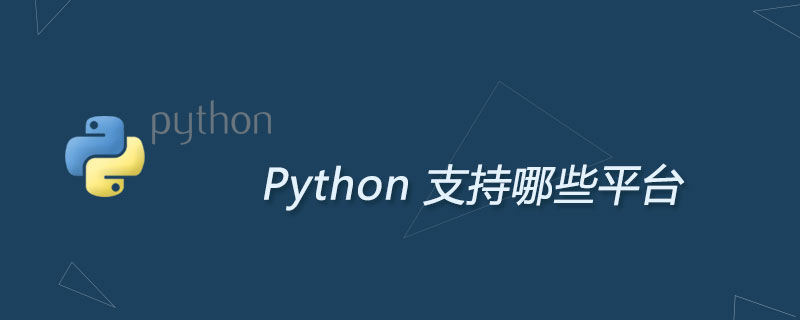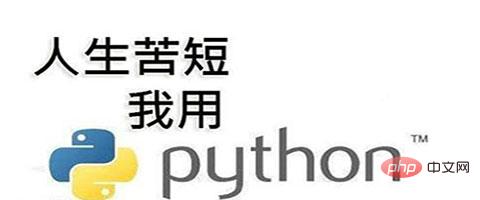Which platforms is Python compatible with?
Currently, Python can be said to be quite popular, including web crawlers, artificial intelligence, data mining and processing, financial quantitative trading, etc. So on which platforms can Python run?
 Python is compatible with platforms such as AIX, HPUX, Solaris, Linux, Windows, etc. In addition to Windows, common Unix and Linux platforms have Native Python, but the version is generally lower. Regarding cross-platform, just like other cross-platform languages, it should be noted that some individual modules are unique to a single platform, but the overall cross-platform performance is still very good. There is no need to write multiple sets of code to adapt to multiple platforms.
Python is compatible with platforms such as AIX, HPUX, Solaris, Linux, Windows, etc. In addition to Windows, common Unix and Linux platforms have Native Python, but the version is generally lower. Regarding cross-platform, just like other cross-platform languages, it should be noted that some individual modules are unique to a single platform, but the overall cross-platform performance is still very good. There is no need to write multiple sets of code to adapt to multiple platforms.
What are the advantages of Python language?
1. Simplicity We can say that Python is a simple language, very easy to read and write. When encountering a problem, programmers can focus more on the problem itself without spending too much energy on it. Programming language and syntax.
2. Free Python is free and open source. This means that programmers can share, copy and exchange it without spending money. This also helps Python form a strong community, making it more perfect and technology developing faster. Professionals can share their knowledge and experience with the community and beginners.
3. Object-oriented Python supports both process-oriented and object-oriented programming. In procedural programming, programmers reuse code, and in object-oriented programming, data and function-based objects are used. Although object-oriented programming languages are often complex, Python manages to remain simple.
4. Third-party libraries The Python community has created a large number of various Python libraries. With their help, you can manage documents, perform unit tests, databases, web browsers, email, cryptography, GUI and many more things. Everything is included in the standard library, however, besides it, there are many other libraries.
5. Python has widespread employment. For many years, Python has been ranked high among various popular programming languages. It can be applied to almost any development, and it is designed to improve the development efficiency of programmers rather than the code they write. Python is suitable for website, desktop application development, automated scripts, complex computing systems, scientific computing, life support management systems, Internet of Things, games, robots, natural language processing and many other aspects. Moreover, Python code is concise and easy to understand, even for those who have never developed experience. Because Python program code is simple, later program maintenance is easier and more comfortable than other programming languages. From a business point of view, the required costs are reduced and the efficiency of programmers is improved
Since Python has so many advantages, what reason do you have for not learning Python?

Related learning recommendations: python tutorial
The above is the detailed content of Which platforms is Python compatible with?. For more information, please follow other related articles on the PHP Chinese website!

Hot AI Tools

Undresser.AI Undress
AI-powered app for creating realistic nude photos

AI Clothes Remover
Online AI tool for removing clothes from photos.

Undress AI Tool
Undress images for free

Clothoff.io
AI clothes remover

AI Hentai Generator
Generate AI Hentai for free.

Hot Article

Hot Tools

Notepad++7.3.1
Easy-to-use and free code editor

SublimeText3 Chinese version
Chinese version, very easy to use

Zend Studio 13.0.1
Powerful PHP integrated development environment

Dreamweaver CS6
Visual web development tools

SublimeText3 Mac version
God-level code editing software (SublimeText3)

Hot Topics
 How to Use Python to Find the Zipf Distribution of a Text File
Mar 05, 2025 am 09:58 AM
How to Use Python to Find the Zipf Distribution of a Text File
Mar 05, 2025 am 09:58 AM
This tutorial demonstrates how to use Python to process the statistical concept of Zipf's law and demonstrates the efficiency of Python's reading and sorting large text files when processing the law. You may be wondering what the term Zipf distribution means. To understand this term, we first need to define Zipf's law. Don't worry, I'll try to simplify the instructions. Zipf's Law Zipf's law simply means: in a large natural language corpus, the most frequently occurring words appear about twice as frequently as the second frequent words, three times as the third frequent words, four times as the fourth frequent words, and so on. Let's look at an example. If you look at the Brown corpus in American English, you will notice that the most frequent word is "th
 How Do I Use Beautiful Soup to Parse HTML?
Mar 10, 2025 pm 06:54 PM
How Do I Use Beautiful Soup to Parse HTML?
Mar 10, 2025 pm 06:54 PM
This article explains how to use Beautiful Soup, a Python library, to parse HTML. It details common methods like find(), find_all(), select(), and get_text() for data extraction, handling of diverse HTML structures and errors, and alternatives (Sel
 Mathematical Modules in Python: Statistics
Mar 09, 2025 am 11:40 AM
Mathematical Modules in Python: Statistics
Mar 09, 2025 am 11:40 AM
Python's statistics module provides powerful data statistical analysis capabilities to help us quickly understand the overall characteristics of data, such as biostatistics and business analysis. Instead of looking at data points one by one, just look at statistics such as mean or variance to discover trends and features in the original data that may be ignored, and compare large datasets more easily and effectively. This tutorial will explain how to calculate the mean and measure the degree of dispersion of the dataset. Unless otherwise stated, all functions in this module support the calculation of the mean() function instead of simply summing the average. Floating point numbers can also be used. import random import statistics from fracti
 How to Perform Deep Learning with TensorFlow or PyTorch?
Mar 10, 2025 pm 06:52 PM
How to Perform Deep Learning with TensorFlow or PyTorch?
Mar 10, 2025 pm 06:52 PM
This article compares TensorFlow and PyTorch for deep learning. It details the steps involved: data preparation, model building, training, evaluation, and deployment. Key differences between the frameworks, particularly regarding computational grap
 Serialization and Deserialization of Python Objects: Part 1
Mar 08, 2025 am 09:39 AM
Serialization and Deserialization of Python Objects: Part 1
Mar 08, 2025 am 09:39 AM
Serialization and deserialization of Python objects are key aspects of any non-trivial program. If you save something to a Python file, you do object serialization and deserialization if you read the configuration file, or if you respond to an HTTP request. In a sense, serialization and deserialization are the most boring things in the world. Who cares about all these formats and protocols? You want to persist or stream some Python objects and retrieve them in full at a later time. This is a great way to see the world on a conceptual level. However, on a practical level, the serialization scheme, format or protocol you choose may determine the speed, security, freedom of maintenance status, and other aspects of the program
 What are some popular Python libraries and their uses?
Mar 21, 2025 pm 06:46 PM
What are some popular Python libraries and their uses?
Mar 21, 2025 pm 06:46 PM
The article discusses popular Python libraries like NumPy, Pandas, Matplotlib, Scikit-learn, TensorFlow, Django, Flask, and Requests, detailing their uses in scientific computing, data analysis, visualization, machine learning, web development, and H
 How to Create Command-Line Interfaces (CLIs) with Python?
Mar 10, 2025 pm 06:48 PM
How to Create Command-Line Interfaces (CLIs) with Python?
Mar 10, 2025 pm 06:48 PM
This article guides Python developers on building command-line interfaces (CLIs). It details using libraries like typer, click, and argparse, emphasizing input/output handling, and promoting user-friendly design patterns for improved CLI usability.
 Scraping Webpages in Python With Beautiful Soup: Search and DOM Modification
Mar 08, 2025 am 10:36 AM
Scraping Webpages in Python With Beautiful Soup: Search and DOM Modification
Mar 08, 2025 am 10:36 AM
This tutorial builds upon the previous introduction to Beautiful Soup, focusing on DOM manipulation beyond simple tree navigation. We'll explore efficient search methods and techniques for modifying HTML structure. One common DOM search method is ex






